Florida manatees, our “gentle giant”, recently brought back from the brink of extinction, is our canary in the coal mine. Long ago coal miners would take a tiny canary underground to alert them of a dangerous work environment full of deadly gasses. What can our aquatic thousand-pound mammal tell us about Florida’s environment?
Fresh off the “endangered” species list, one will find manatees in our waters with emaciated bodies, some pockmarked with cold stress sores, and most of them riddled with scars across their backs.
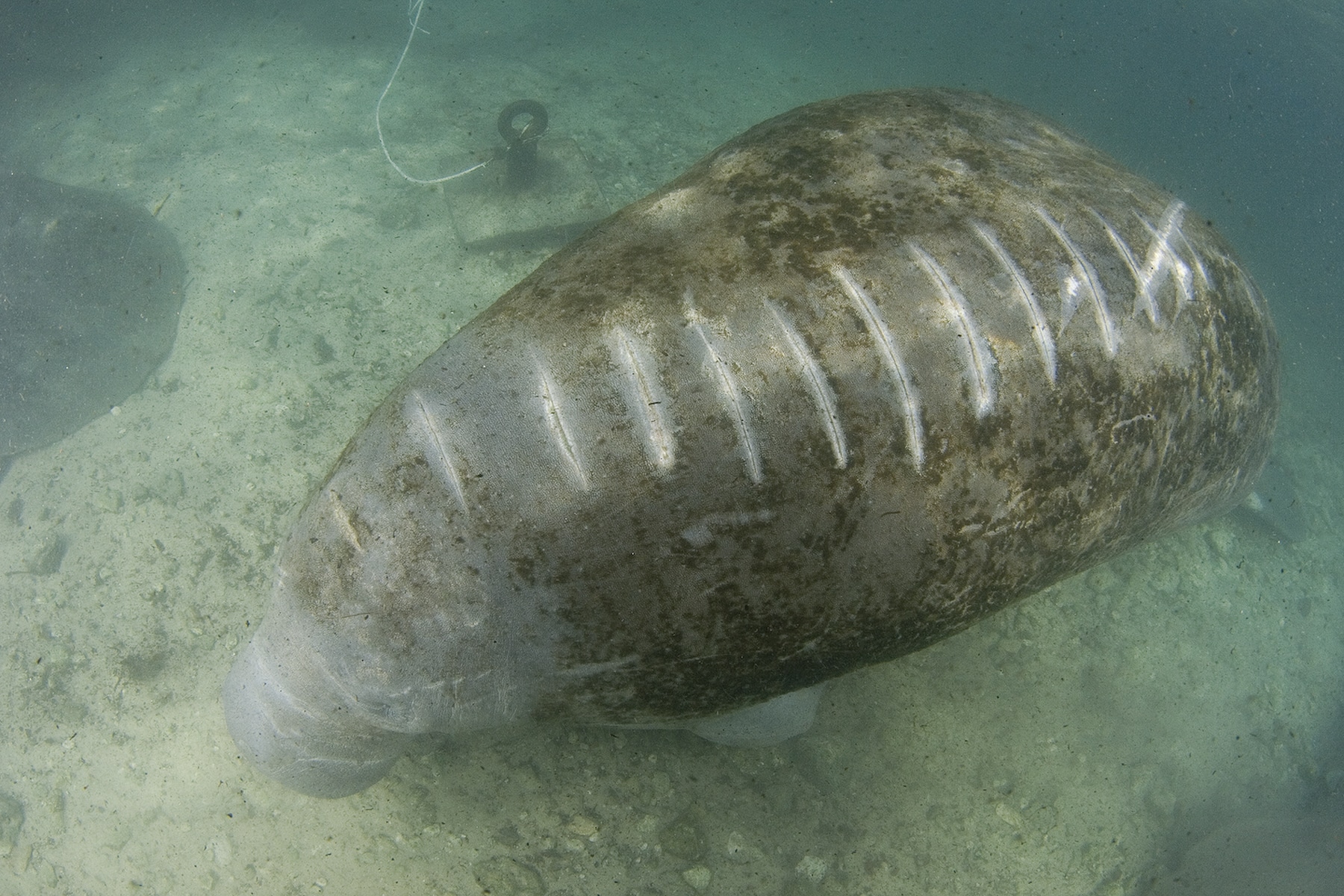
Severe injuries from a boat propeller. ©D.Schrichte/manateepics.com
And right now, as you read this, a desperate and controversial manatee rescue mission is taking place on our east coast. Heads upon heads of lettuce are being fed to manatees to prevent another mass casualty event.
Speaking of feeding, for generations the public has been fed a steady diet of press conferences staged with various government officials standing at a podium, water in the background, touting another successful restoration project. Even the bad stuff is fed to us via fancy government-run websites with graphs showing real-time algal blooms, red tides, and Lake Okeechobee discharges.
How about we all pull our heads out of the sand and stick them underwater to see a manatee and her calf – that’s all we need to see to know troubling times are upon us. What is their condition telling us – and who’s to blame?
Is it “big ag”? What about “big bad corporations”? We owe it to our beloved gentle giants to get to the bottom of this and fix it…
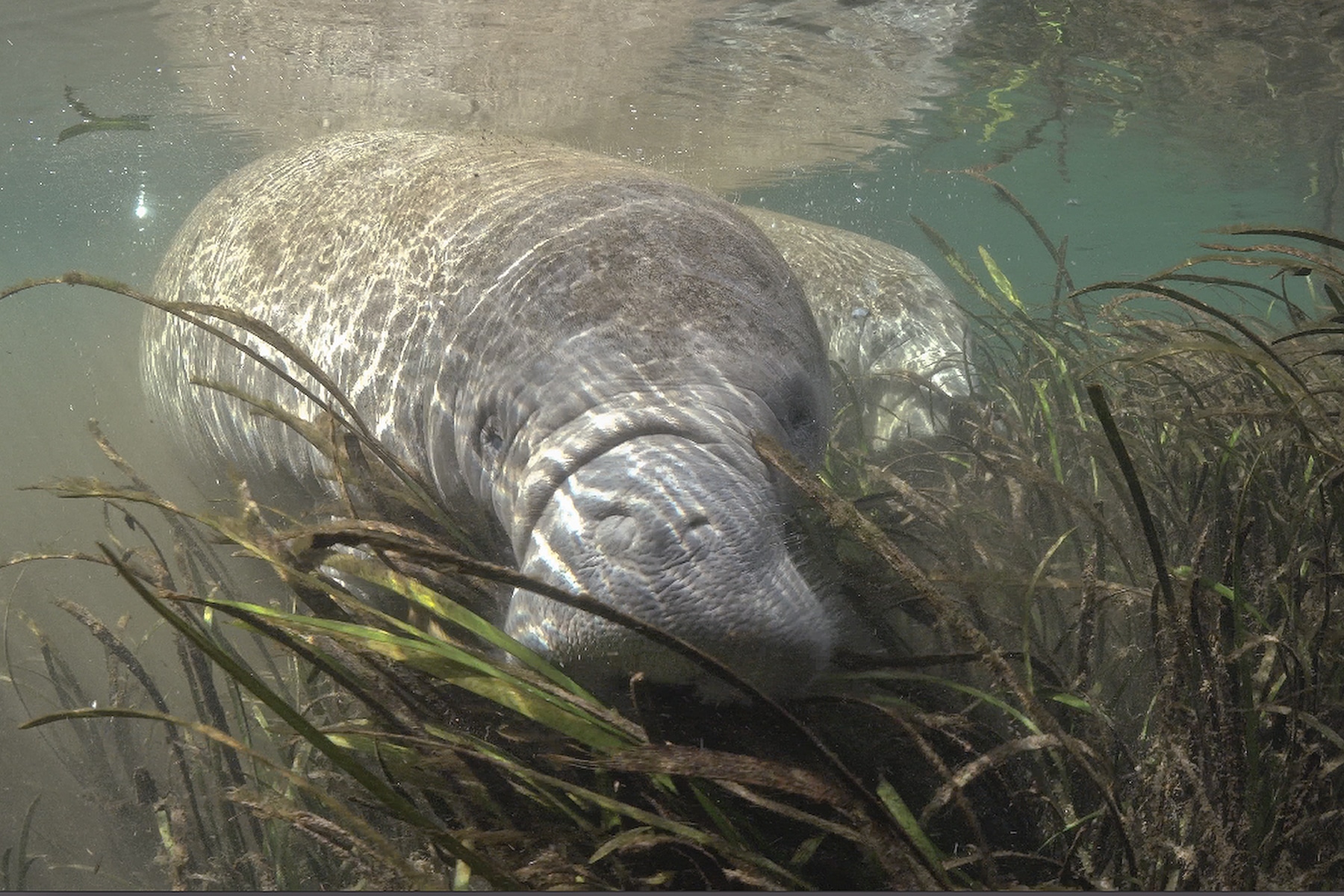
Manatees eating eelgrass coated in algae from excessive nutrients ©D.Schrichte/manateepics.com
Estuary Health Spotlight
Our gentle giants live and raise their young in our shallow shoreline waters – they live in the bottom of the barrel, relative to our developed lands. They swim long distances against tides and strong currents to reach safe wintering waters. Manatees, believe it or not, have little body fat. Imagine them having traveled more than 100 miles, burned all those calories, and not being able to find enough food to re-nourish or to nurse their young. Every single manatee must find and consume nearly 100 pounds of submerged vegetation every day. If there is very little estuary seagrass (or eelgrass in freshwaters) they are at high risk for starvation and cold stress during the winter. Florida’s estuaries are becoming danger zones, instead of sanctuaries, for our beloved vegetarian mammals.
- Indian River Lagoon (IRL) – Just last year the starvation and death of nearly 1,000 manatees was labeled an “Unusual Mortality Event” (UME). Unusual? Far from it. Back in 2011 an algae superbloom wiped out over 45,000 acres of seagrass in the IRL! Oh, and then in 2013 world news agencies were reporting on deaths of manatees, bottlenose dolphins and pelicans – calling the same lagoon a “killing zone.” So let’s describe this event as sad or preventable but there’s nothing unusual, as this catastrophe has been brewing for a long time.
- Tampa Bay – The life and blood of the booming area economy just experienced one of the worst red tides on record. And (no surprise) that event was immediately following another millions-of-gallons nutrient-rich wastewater spill from an abandoned and mismanaged phosphate mine. And let’s not forget about the bacteria and nutrients coming from frequent untreated wastewater spills into the bay after rainstorms. What a coincidence that underwater surveys are finding seagrass beds dwindling.
- Biscayne Bay – Florida’s most developed and populated coastline down south has become a biological desert. It’s hard to find any underwater grasses in the bay necessary to sustain a healthy food web. It has gotten so bad that industrial pumps were placed along the shoreline to attempt to pump life-sustaining oxygen into the waters.
- Kings Bay – Luckily, there’s a beacon of hope on the Gulf coast just north of Tampa in Crystal River. Although more sparsely populated compared to other bays, a community and nonprofit effort to dredge sludge and replant beds of healthy submerged eelgrass has found success! Stay tuned, as next month, our Play Hard Florida production team is going to bring our manatee-safe boat and underwater cameras to capture a snapshot of the recreation trends and restoration efforts.
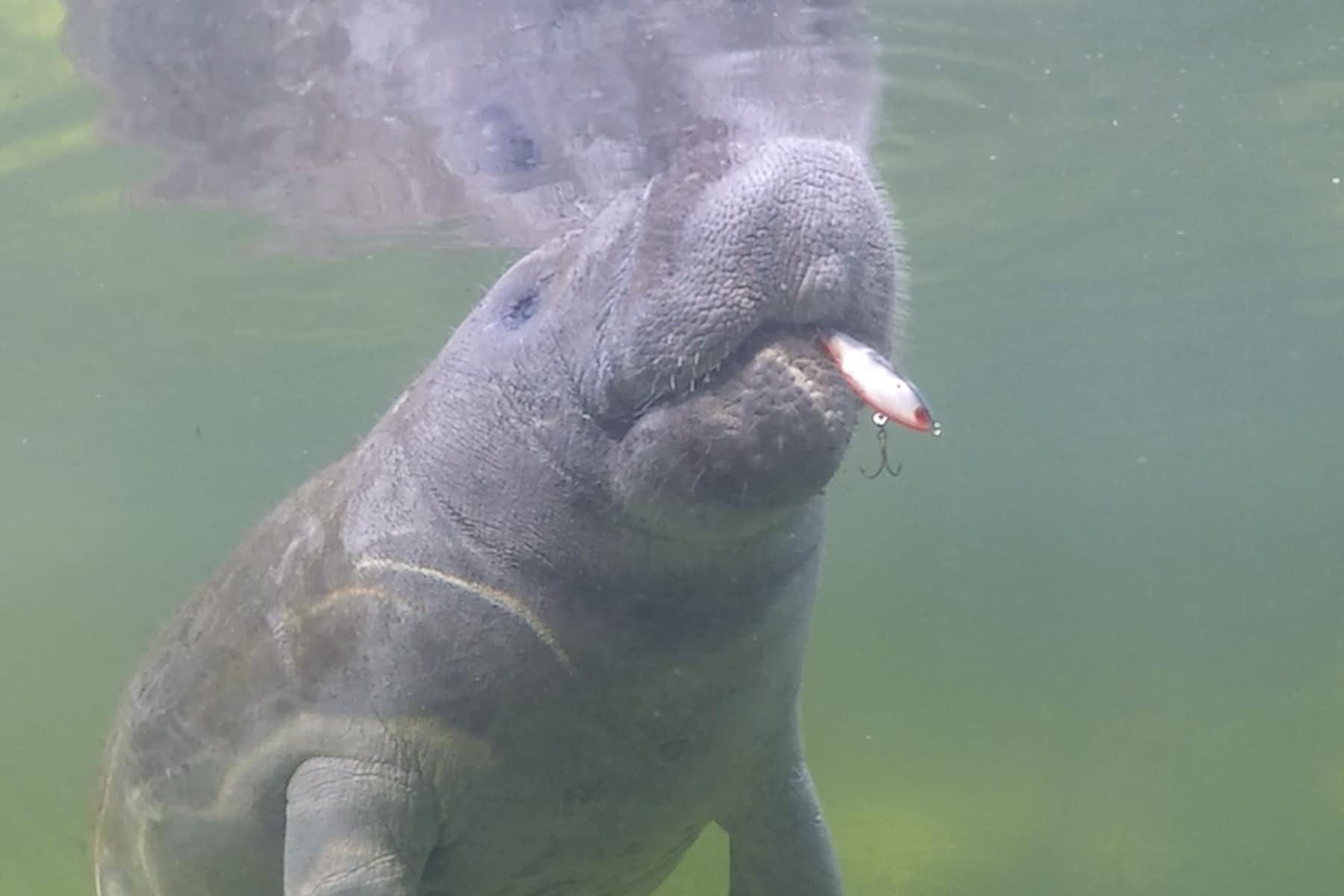
A fishing lure stuck in a manatee’s mouth. ©D.Schrichte/manateepics.com
Everyone’s Favorite: Recreation
What about all those scars Florida manatees have running down their backs? Recreation: this one ruffles canary feathers and hits home for many of us. With 21 million COVID-avoiding, nature-seeking state residents AND 100 million tourists a year flocking to our waters, there are both obvious and not so obvious recreation effects.
- Boats – It’s no surprise we have the highest number of registered boats in the U.S. – approaching 1 million! (We are the “Water State” after all – let’s rename it!) It’s rare to see a manatee with no propeller scars on its back and broad tail. What is less noticeable and more often deadly are collision injuries from speeding boats.
- Fishing – While it may not seem too big of a deal to snag a lure or two along the shoreline, collectively, the millions of people fishing in our waters adds up to lots of gear left behind. Manatees get entangled in the monofilament fishing line and barbed hooks. Commercial fishing gear & crab traps are entanglement threats as well.
- Human encounters – “Swim with manatee” experiences are growing in popularity, as are manatee sightseeing cruises and paddles. If passive observation is not practiced both above and below the waters, it can cause disturbances to manatees’ behaviors, to the mothering of their young, and their foraging needs.
- Springs recreation – Tubing, free diving, scuba diving, paddle boarding, and kayaking at our inland freshwater springs can cause manatee impacts from behavior disturbance and from the trampling of the eelgrass. As more frequent red tides, algal blooms, and beach closures occur, locals and tourists will head inland to our clear, cool, springs and spring-fed rivers – thus impacting more inland manatee habitat.
Don’t move your scarless tail, as we’re getting closer to figuring this out…
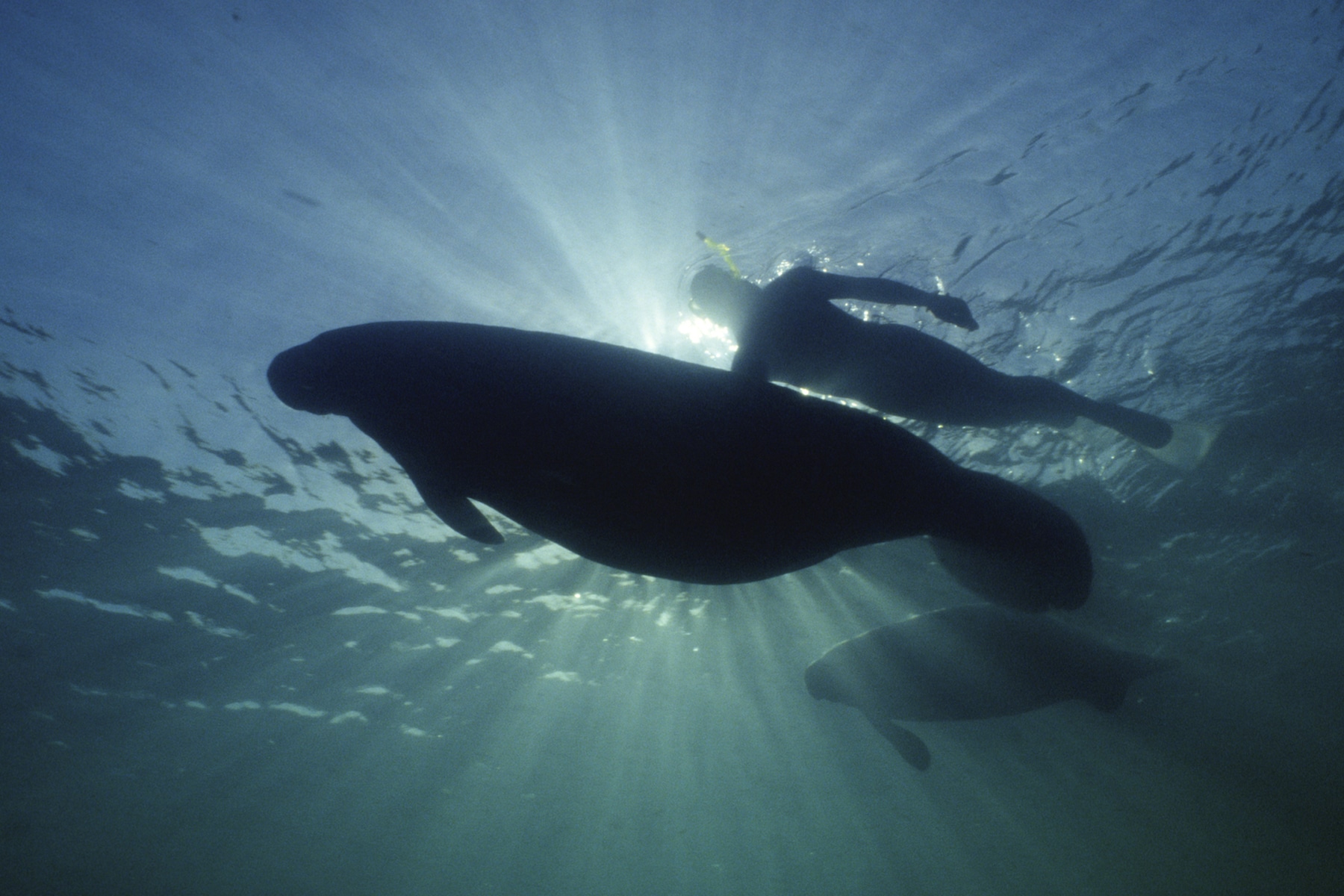
A tourist swims among our gentle giants in Crystal River. ©D.Schrichte/manateepics.com
Population Growth
Every day, nearly a thousand people are moving here to enjoy our waters! To fix the overcrowding, state politicians were poised to use 26 BILLION of our own tax dollars to build some new highways. Imagine manatee health (and ours) if Tallahassee had the same drive (or political pressure – hint hint) to invest that kind of money into improving our waters! Again, our gentle giants are sacrificing life and limb to show us the way we’re growing is not sustainable. Remember the 156-mile long Indian River Lagoon (you know, where all the manatees starved to death last year); have you seen all the new residential subdivisions popping up around that amazing water body?
- Lawns – How many millions of acres of our diverse natural lands have been converted to residential and commercial lawns in Florida? “Our green costs us our blue.” Today’s fixation on having a bright-green lawn ultimately costs us having blue waters tomorrow! (Read about our state’s most wasteful crop.) Remember that manatees live at the bottom of the hill – all the pesticides, herbicides, and fertilizers that get put on our lawns end up where they are raising their young. Did you know a recent study found Glyphosate, the most commonly used herbicide (main ingredient in Roundup), in the blood of more than half of the manatee tested?
- Water use – More than 22 million Floridians (and millions of tourists) flush the toilet on average 5 times a day; many sunburnt tourists take long cold showers; lawn watering still accounts for a majority of the residential water use across the state. Florida ranks among the highest of all 50 states for per capita water consumption! The more water we pull from our underground Floridan & Biscayne Aquifers, the more saltwater intrusion occurs, lessening the freshwater for drinking for both us and manatees – and a reduction in springs that provide them with thermal refuge in the winter.
- Exotic species – With population growth comes continued exotic plant and animal species introduced into our lands and waters. Just as native-species-killing Burmese pythons have been released in the Everglades, people release non-native aquarium fish into our waters. It’s hard to find manatees in freshwaters without the invasive Plecos armored catfish clinging to their scarred backs, altering their behaviors and ability to rest.
- Habitat loss – Who can blame locals or new residents for wanting a home on the water? And who can blame them for wanting a dock and a reinforced shoreline to provide sight-lines and access to a beautiful sunset and boat? Unfortunately, those structures and boats shade out submerged grasses and create more entanglement hazards. Shoreline construction in the form of seawalls or piled rocks reduce the emergent vegetation that manatees eat and that is key to the entire aquatic food web.
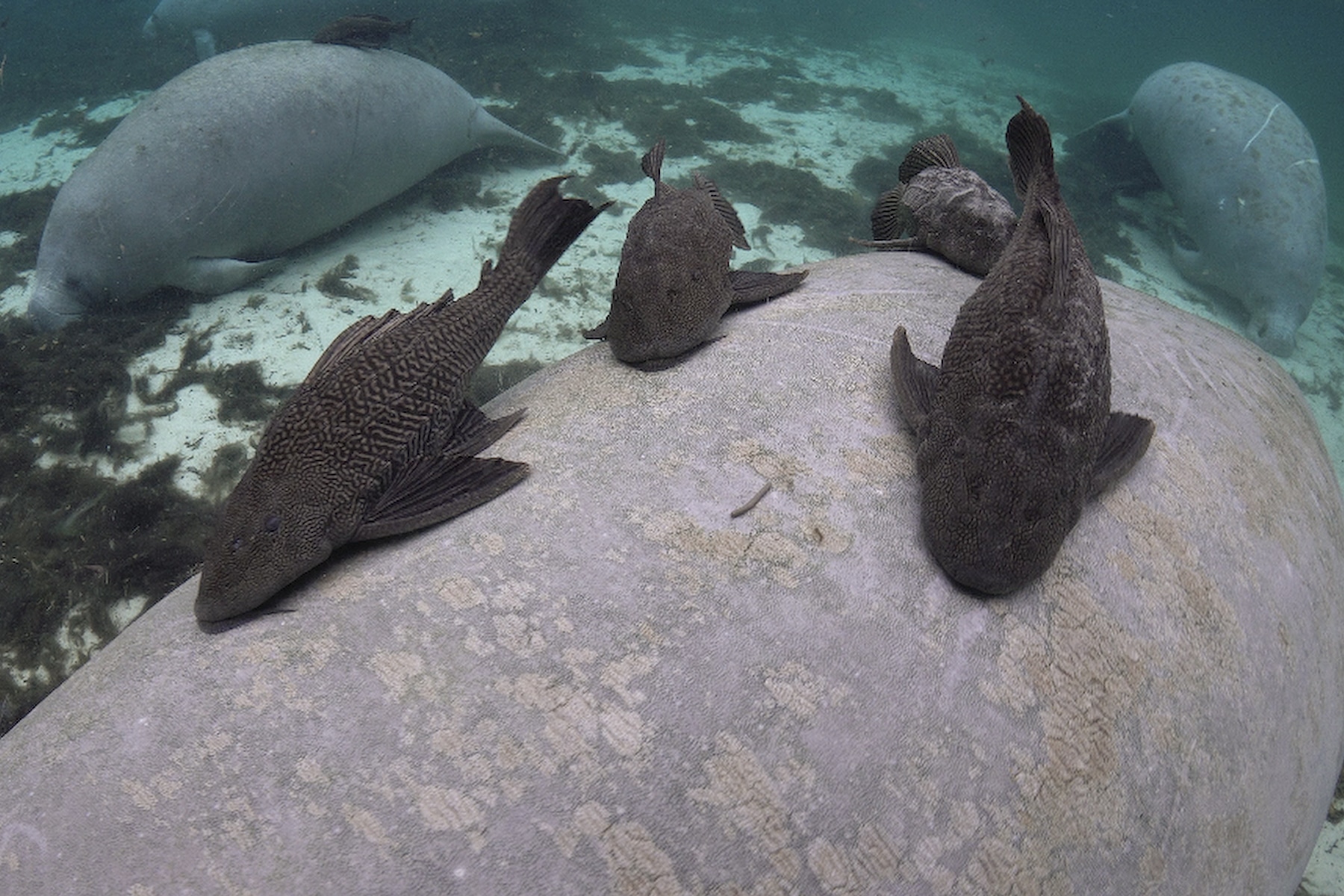
Armored catfish on the backs of manatees. ©D.Schrichte/manateepics.com
Tax-Funded Water Management
How does managing our vast network of natural and unnatural water bodies impact manatees? As you can see, impacts pressuring our manatees create a complicated web of intertwined issues. Are you (or your canary) still breathing? We’re close to a culprit!
- Navigation – Remember that there are one million boat owners (and millions of tourists) dreaming of jumping in the boat for a weekend water escape. The government ensures there are no navigation hazards, such as aquatic weeds to slow anyone down. Unfortunately, to keep our waters clear, we’ve created an entire aerial spraying industry that even uses helicopters to spray rivers, canals, and lakes across the entire state. Don’t take our word for it – the amount of herbicide use in our state makes national news too. Again, as noted above, so much spraying that the chemicals are found coursing through the veins of our friendly giants!
- Flood control – Remember all those subdivisions, like mine and yours, you see popping up everywhere? Government agencies are in charge of keeping neighborhoods from flooding. Moving stormwaters off of the landscape faster, instead of slower, contributes more pollution to our estuaries. And you guessed it – to keep the stormwaters moving, herbicides are used to keep the vegetation from slowing the water. Also, necessary infrastructure such as pumps, weirs, dams, and lock systems create additional entrapment risks.
- Lake Okeechobee releases – In the name of flood control, government agencies are forced to release nutrient-rich, dark-colored, and algae-laden waters to both coasts to prevent flooding to surrounding communities. If our state government calls those discharges “harmful” to humans (and they do), imagine the impacts to the much more vulnerable food webs in our manatee habitats?
- Groundwater use – You’ve heard of Consumptive Use Permits – they’re issued to cities to supply our water-hungry residents, issued to industry to make products we order on Amazon, provided to farmers to grow our food, issued to our power plants, and issued to water bottling companies. What does it matter? Too much water withdrawn from our Biscayne & Floridan aquifers results in saltwater intrusion – forcing manatees, and eventually humans, to find farther inland sources of drinking water. In the winter, reduced flow from the freshwater springs can create cold stress for manatees searching for thermal protection (spring water is warmer than Atlantic/Gulf or river waters in the winter). Also, lowered aquifer levels/spring flow can allow more algae growth on the submerged eelgrasses, which can kill it or lower the rate of regrowth after the manatee graze on it.
- Invasive weed control – A double edge sword – government agencies also work to keep the non-native plants under control and from crowding out native species. You guessed it – they do it from spraying more of that nasty stuff. By now you know just how crazy we are in Florida with our addiction to weed killers!

This mother requires lots of nutrients to nurse two calves! ©D.Schrichte/manateepics.com
Water Quality not Quantity
This is the obvious (aquatic) elephant in the room. For a state in which tourism is the number one industry you would think this would be the least of the manatees’ worries. Sadly, it’s one of the most impactful.
- Outdated wastewater infrastructure – We continue to keep our neon “open” signs flashing at the state line – encouraging more seaside condos to be built, flushing their new toilets into our outdated sanitary sewer collection and treatment systems. Our state is decades and billions of dollars behind on fixing our sewers, and they spill quite often into our estuaries and bays. Add to that, our state is slow to convert ineffective septic systems. The bacteria are infecting waters and the nutrients from the untreated sewage and septic systems are fueling our algal blooms.
- Stormwater infrastructure – Thankfully, newer subdivisions have stormwater treatment, but many cities are overdue on updating older urban areas that have little to no treatment, and they discharge directly into surface waters. Parking lot runoff, trash, and all the chemicals we put on our commercial and residential landscapes are concentrated in our collection systems and end up in our manatee-dwelling waters.
- Industrial spills & discharges – Sure, we need industry (jobs) and are proud of our “made in Florida” products, but sometimes things feel out of whack. Fishermen or women can spend months in jail and get fined hundreds of dollars for putting the wrong fish in the cooler. Industry can have a spill that kills literally hundreds of thousands of aquatic organisms, fish, birds, turtles, throw some manatees in too and then…do it again….and again….and again!?! Power plant warm-water discharges also may be encouraging manatees to migrate farther north than normal in the winter months.
- Agriculture – This is another canary-feather-ruffling topic, especially to both our coasts receiving Lake Okeechobee discharges and also in springs country in North Florida. Farms rely on fertilizer, herbicides, and pesticides to maximize crop yield to put food on our tables. The push is to “grow local” but that comes at a price when the algae-fueling nutrients and pesticides have the potential to escape the fields and get into our ground and surface waters. Agricultural Best Management Practices (BMPs) have been used for decades but big changes are needed as they’ve proven they are far from being “Best Manatee Practices.”
- Red tides / algal blooms – Our big aquatic mammals are strong swimmers, but they are only able to raise their nostrils an inch or two above the water surface to breathe. They have no escape from the toxic fumes during the events. It kills them. Of course algae is naturally occurring in our fresh and marine waters but if we don’t get serious about fixing all of the above, plan on more suffocating silent screams from our young and old “canaries.”
If you made it this far, you are genuinely concerned and soon, we can call out the real culprit!
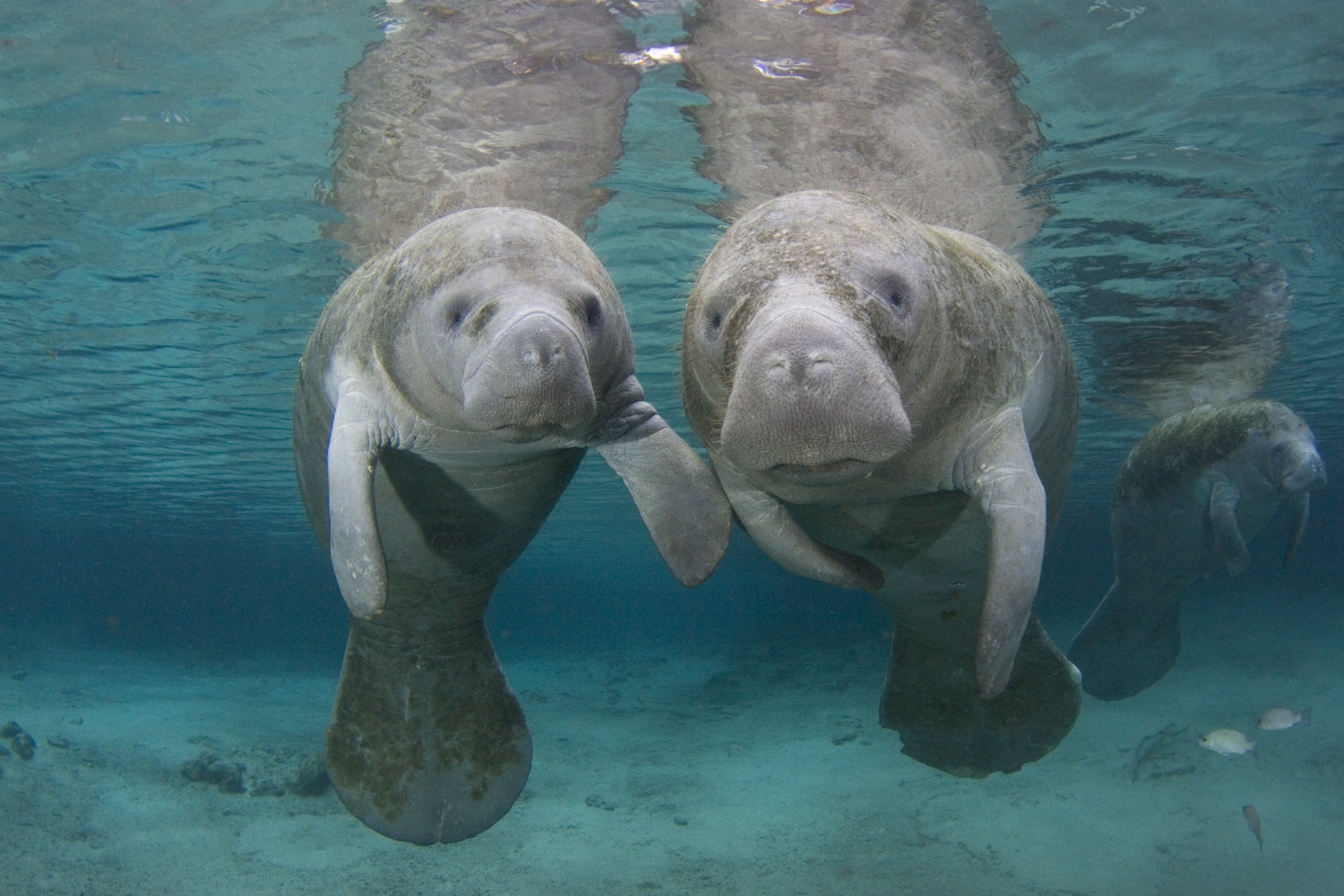
Florida manatees finding a warm water refuge but no grasses. ©D.Schrichte/manateepics.com
Blame Global Warming
Won’t warming waters help reduce the number of manatees experiencing cold stress and expand their range? No and yes. Can we just blame the manatee deaths on climate change? Not at all.
- Weather changes – Weather systems increasing in intensity and frequency can produce heavier rainfall events causing more sanitary sewer overflows and more polluted runoff from farms and subdivisions. High energy hurricanes can cause sediment plumes and alter salinity (salt) levels affecting submerged vegetation across our bays and estuaries too.
- Sea level rise – Much needed shoreline armoring and seawall construction to combat (and pump) rising waters may further impact manatees’ ability to forage along the shorelines and will create mechanical hazards with sumps and pumps. Let’s not forget as the saltwater rises (combined with over pumping from our aquifers) the salt intrudes farther inland – making manatees burn more calories to seek freshwater sources. Higher King Tides and storm surges can strand manatees on dry land when waters recede.
- Warming waters – Warmer surface waters can increase frequency and duration of algal blooms. No – we can’t just spray weed killer from helicopters to make the algae go away. Speaking of Glyphosate-based weed killers, remember all the tax-funded spraying in lakes and rivers we’ve been mentioning? All that dying vegetation and the chemical itself fuels even more algae blooms! Talk about tax dollars that don’t work for manatees – or for Floridians.
So as you can see, our hungry, heavily-scarred canary has a lot to warn us about. We’ve made a mess of our environment. They are underwater screaming about our unsustainable path. Hear their cries: if we don’t change course immediately, the manatee population, community health, tourism, and our economy is at risk of failing. Just 30 years ago, 13 million of us citizens brought our manatees back from the brink – we now have a 21-million-strong army to fight and make changes for our whiskered friends! But who’s going to take responsibility?
It’s no one’s fault – it’s a “Florida” problem. We all have a hand (or fin), or propeller, in the health of our manatee population and we have to act (and vote). Many of us love our lawns, we love our boats, we love to take our kids fishing, and wow – how special is it to see our gentle giants underwater? A vibrant and healthy manatee population is a vibrant and healthy place to live!
Manatee-saving Actions
- Share this article with your friends, lots and lots of government officials, family, and neighbors!
- Sign up for our newsletter at the bottom of this page as we’ll be releasing a followup article detailing how we can save our beloved aquatic mammals (and Florida).
- Follow us on YouTube – in just a few weeks we’ll be diving into our first “Water State” series videos in Kings Bay, Crystal River! Our team will be loading up our custom manatee & seagrass-safe boat and camera gear to get a first hand, above and below the water, look at tourism, restoration efforts, and the health of the wintering manatees.
- Start thinking about little and big “Best Manatee Practices” you can implement at home and at work – our gentle giants (and our children) deserve better!
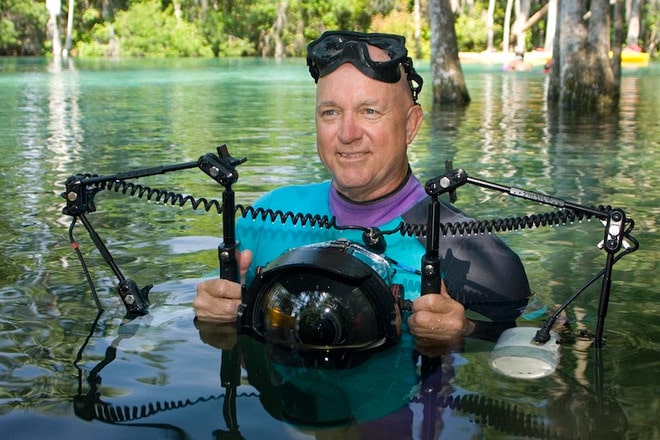
Special thanks to David Schrichte for being an advocate for our Florida manatees and providing the photos. Please show your support of his efforts by visiting his website manateepics.com, featuring his amazing underwater photography!

